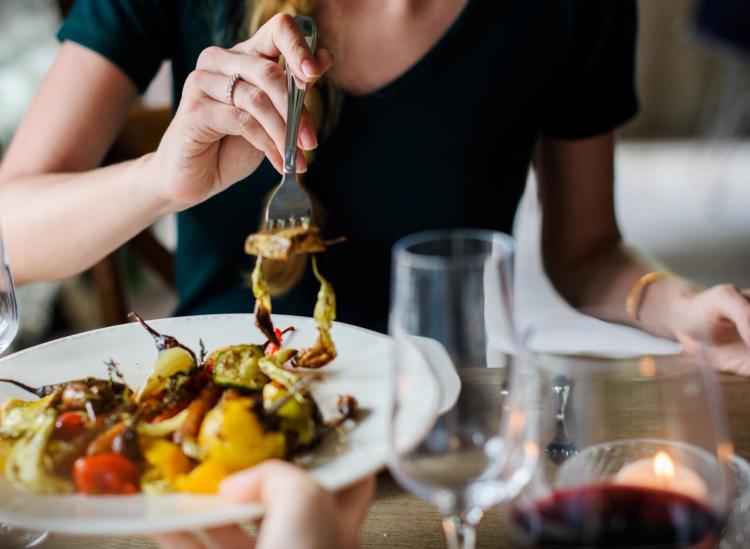10 Easy Tips To Spend Wayyy Less On Food

Pexels
If you’re anything like us, you love to go out to eat — brunch is your jam — and Seamless is one of your guiltiest pleasures…and common pastimes. But when you check your bank account balance at the end of the month, you’re always shocked and confused. Where did all my money go?
We know where your money went, and we’re about to give you the inside scoop to save a boatload of cash on food every month. And no, you won’t have to give up all the deliciousness to do it.
The first step to addressing a problem is admitting you have one, right? Take a hard look at your bank account to assess the damage done in previous months. (Even better: download a budget app that will help you identify the patterns of how you spend money on food.) Does all your cash go to delivery, or are you overspending on groceries? It’s important to know what you’re dealing with before trying to fix it. Once you’ve gained some insight into your spending, consider the tips below to save money on food.
1. Delete your food delivery apps.
We know, it’s probably the most painful way to spend less on food. But trust us when we say that you’ll be less prone to those late-night splurges if you have to go to the app store, re-download it and sign in again just to order your fave Chinese food. And if delivery is a must, limit it to a specific number of times each month. Take it a step further: Make a deal with yourself that you have to walk to pick up the food so that it’s a longer process and something you’re less eager to do.
2. Learn to meal prep like the boss you are.

Sami Allen
You knew this one was coming. To those of you who don’t cook often, believe us when we say that meal prep doesn’t have to be scary. Come up with a game plan that includes easy dishes that you can handle making. (Our chili and chicken and dumplings recipes are easy, quick and awesome). Enlist the help of a recipe-finding app if you need some inspiration. The key is to be making more of your own meals, and to make those meals last. That means less delivery and eating out for lunch.
3. Buy in bulk.
Raise your hand if you have an Amazon Prime membership. If your hand is raised, there is no reason why you shouldn’t buy many of your groceries in bulk through Prime Pantry. If you don’t have Prime, you can still buy in bulk at the grocery store or through an online delivery system. Buy foods that you eat frequently that won’t go bad quickly, like frozen veggies and chicken breasts.With foods like chicken breasts, you can bag them individually, freeze them and thaw them when you need them. Basically, you’ll save some extra bucks.
4. Don’t buy frozen meals or prepared foods often.
Though $1 frozen meals do exist and you certainly could stock up on them for every meal, making a big, simple pasta dish will ultimately save you more money than relying on the standard $3 Lean Cuisine. And don’t get us started on prepared foods, which can at times be pricey AF. Cook that pasta dish once and get multiple servings out of it that you can freeze and eat as you wish. Plus, what you make will be way more delish than the frozen stuff.
5. Embrace meatless meals.
It’s not a surprise that meat isn’t always the cheapest option. So go meatless for a few meals each week. Just make sure to eat protein-rich foods like black beans and chickpeas to replace the protein you lose from cutting out the meat. A can of black beans or lentils is a lot cheaper than a small pack of chicken breast.
6. Download money-saving Chrome extensions.
If you buy food online through grocery delivery services or through Amazon, you may not have known that there are Chrome extensions specifically designed to save you money on those purchases. You could save a few dollars just by hitting download. It’s that easy.
7. Only buy in-season produce.
Though you probably know that strawberries cost more in January than they do in July, start paying close attention to what produce is in season. Buying fruits and veggies that aren’t in their prime costs more than what’s seasonally available. Good news: there’s a lot of produce that’s always in season beyond what you’ll find just in the spring, summer, winter and fall.
8. Repurpose meals and ingredients.
Similar to meal prepping, you gotta know how to maximize the use of your ingredients. Whether it’s making a bomb bolognese from your leftover turkey dinner or transforming the last quarter of a jar of tomato sauce into a killer meat marinade, nearly any food can be repurposed into something else to save you money. Think creatively about how to eat up your half-eaten or half-used meals.
9. Minimize eating out at restaurants.

PXHere
We’re not about to tell you that you should only go to restaurants for special occasions, but if you’re eating out multiple times a week and are confused about where your money’s going, you need a wake-up call. Limit yourself to a specific number of restaurant nights out per month. The big point is to cut down on the money you spend at restaurants, but if you have to go out, split dishes with others, or have a snack before you go so all you need is an appetizer to be full.
10. Make a grocery list and stick to it.
You’ve probably heard that going to the grocery store hungry is a big no-no, and we wholeheartedly agree. Who hasn’t stocked up on that very unnecessary bag of tortilla chips and guac because they forgot to eat lunch beforehand? To build on that point, make a solid, well-thought-out grocery list before going to the market and stick to the plan. If you need to, map out the departments you’ll hit, in what order, and label the foods you need in each department.











